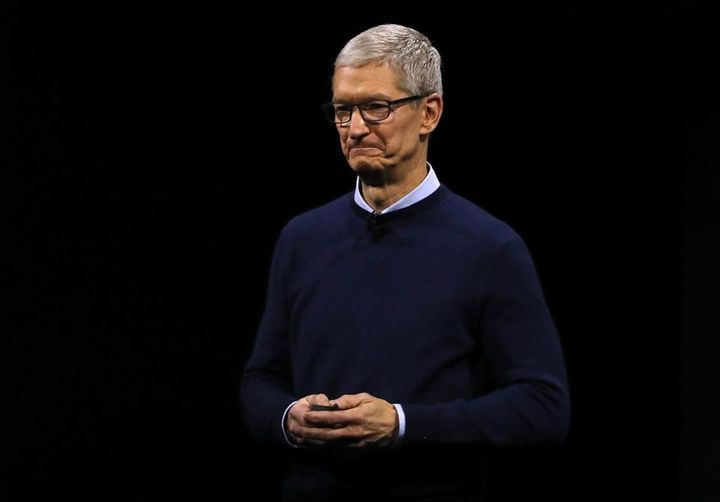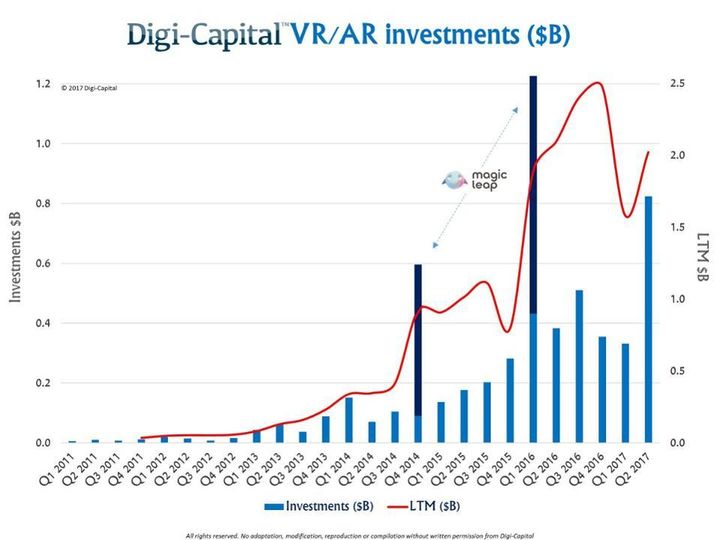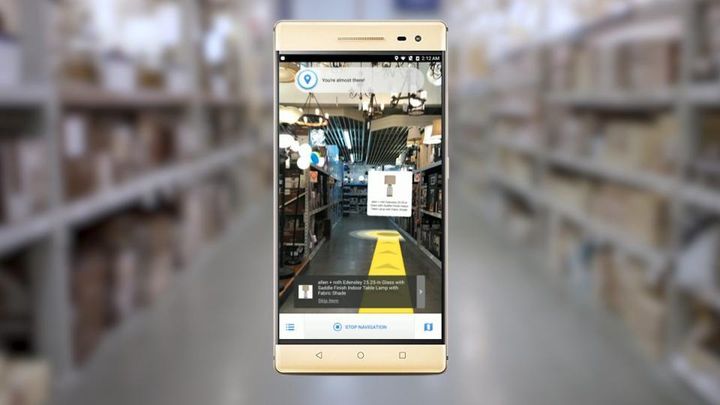
Apple CEO Tim Cook delivers the opening keynote address the 2017 Apple Worldwide Developer Conference (WWDC) at the San Jose Convention Center on June 5, 2017 in San Jose, California. (Photo by Justin Sullivan/Getty Images)
This post was originally featured on Forbes.com on July 05, 2017
The release of Apple (NASDQ: APPL) ARKit developer tools gives us all a taste of the iPhone 8 to come. It should be no surprise that venture activity is up. There are core apps, like marker makers and readers, which have implications for all the other apps. As with today’s iPhone, Apple will only own a few of the most critical of these. Expect most of the big companies like Google and Facebook to quickly add new AR enabled features to their apps. Still, while allowing the big players to make what they do better, Apple AR is so powerful and impactful it will create opportunities for new services. There are new killer apps out there, waiting to be built into the next Uber or AirBnB.
The first to take advantage of these new capabilities is surely Apple itself, which has the dramatic advantage of owning its own hardware-software ecosystem. While leading apps from companies like Facebook, will use AR to make what they are doing better, it also allows Apple itself to take another shot at integrated search and mapping. Their ability to shape the market cannot be understated. At the same time, there are still vast opportunities across multiple categories, like facial recognition, that are going to create new services as yet unimagined or unveiled by as yet unknown entrepreneurs.

Digi-Capital’s chart illustrates investment activity in Augmented Reality through Q2 2017.
Digi-Capital, a Menlo Park based AR/VR adviser, recently released a new Augmented/Virtual Reality Report Q3 2017, which has been revised significantly to focus on the changes to the market from Apple/Facebook entering mobile AR. Tim Merel, Digi-Capital’s Managing Director, says the new report captured over $800 million invested in AR/VR companies in Q2 2017, with over $2 billion invested in the last 12 months. “While investment hasn’t hit the record peak of Q1 2016 (when $1.2 billion was invested in the quarter and $2.4 billion in the previous 12 months), the second quarter of this year was an investment record for a quarter when Magic Leap wasn’t sucking in giant amounts of cash. Facebook’s Camera Effects Platform and Apple entering mobile AR software (and potentially hardware later this year) look set to recalibrate investor sentiment on the sector as a whole.”

Brand new infographic showing venture investors across the MR ecosystem.
The first most amazing thing iOs 11 (for which iPhone 8 will be optimized) will do is SLAM (simultaneous localization and mapping), which makes location a matter of inches, not yards. A user points their app at a street address, which acts as a trigger in an AR app and brings up a list of occupants. Give a social twist and one can imagine leaving a note for a friend “pinned” to that location. Hold your phone up and suddenly labels and marketing messages, even art, might pop up all over the place. A year from now, markers will be everywhere. We’re going to need marker message filters.
With the new phone’s multiple, depth sensing cameras, the screen becomes a window into the world where data and reality mingle seamlessly. Point your camera down the street and see it overlaid with addresses and businesses, mingled with social media notifications, and marketing (maybe we can pay a fee to remove it?). Your friend’s office is here. Your best friend ate in this restaurant and liked it. Click on menu. By the grocery, a popup notice tells you Kellogg’s is giving away Rice Crispies. A billboard or display ad in the subway will become a portal, with information, directions, video and social media. A department store might light up your whole screen with augmented reality messages, offers and images. Everything could be gamified with loyalty points. Years before there are consumer AR head mounted displays, we will start to view the world through our cameras, interacting with information, data and images in an entirely new way. Mark Zuckerberg said at the Facebook developers conference in April that “Facebook is making the camera the first augmented reality platform”. Apple has fulfilled that promise.

Facebook's F8 Developer Conference on April 18, 2017 at McEnery Convention Center in San Jose, California. (Photo by Justin Sullivan/Getty Images)
Tim Merel says Digi-Capital’s analysis reveals that “one pattern remains constant for AR/VR Dealmakers, with half of all investment continuing to pour into core tech companies. The four other big investment sectors were video, games, peripherals and smartglasses, which together with tech account for just under 90% of all AR/VR investment. Around $1 of every $10 was divided between solutions/services, education, social, advertising/marketing, navigation, location based, and eCommerce. The rest was spread across the smaller investment sectors of art/design, entertainment, business, lifestyle, music, enterprise/B2B, utilities, news, medical, sports, photo and distribution. Again as the impact of Facebook and Apple filters through the mobile AR startup ecosystem, an explosion of new app types could lead to a rebalancing between investment sectors.”

AR application created with Google Tango, available on new Pixel, Lenovo and Asus phones.
Lowe’s (NYSE: LOW) Innovation Labs recently demoed an AR application that uses SLAM (simultaneous localization and mapping) on a Google Tango enabled phone to find products in the store. Holographic representations of items with price and other information are mingled with marketing to change the retail experience.
Jelmer Verhoog, a 32 year old Interaction Designer from Oslo, Norway, used Apple ARKit to put an as-yet unreleased Tesla 3 in his driveway, where he could walk around it, change colors and even have it drive through the city.
Markers for education could be all around us here in the city of New York. Every address could be a historical marker in a place like this. Children might see learning as discovery. Embedded in the Palisades across the river could be its dramatic geological origin story. Imagine an educational app that tells you when you are in or near a historic place. Point your camera at the hill, and watch a revolutionary war battle unfold there, as it did 250 years ago.
Digital characters in an entertainment or game App could hide behind real objects, like a sofa. Massive Multiplayer games like Clash of Clans and Mobile Strike are going to get a lot more compelling as battles play out among your furniture.
Facial recognition and SLAM might combine with social media contacts to allow you to find connections at a crowded reception, conference, concert or sporting event. For people with big networks, at conferences and meetings, this is a killer app.
In the coming years, we will see fewer and fewer people looking at the phone in their hands as they walk down the street. Instead, they will be looking up and out at their screens. This will no doubt create demand for the more practical, untethered AR glasses, which are still years off. The AR phone’s form factor is terrible, and this may drive demand for a better, wearable solution. In the meantime, perhaps someone will introduce an appliance that holds your device up in front of you. Speculation about an Apple wearable i-Glasses in 2020 has already begun. Apple CEO Tim Cook famously pointed out that Apple is rarely first, but it always best.
That was more than five things because when you really start to think about it, everything is going be touched by Augmented, or Mixed, Reality. The Internet of Things, your fridge talking to you, all this will be made possible by AR phones, because suddenly there’s a unified graphical interface for this data, and a simpler way to manage it. Apps like this are gong to create a lot of value.
This column is a companion piece to “Apple AR Is Already Blowing Up” published on Forbes.com on Friday, June 30.
______________________________________________________________________
Charlie Fink is a former Disney, AOL and AG Interactive executive who writes about VR, AR and new media. In the 90s he was EVP & COO of VR pioneer Virtual World Entertainment. Linkedin
